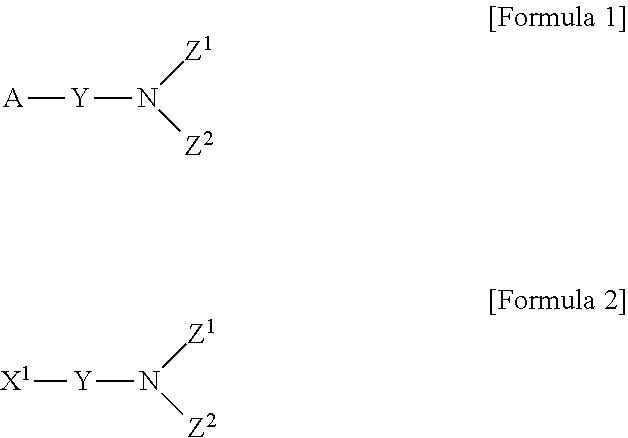Method for preparing aminosilane-based compound
a technology of aminosilane and compound, which is applied in the field of new aminosilane-based compound preparation methods, can solve the problems of reduced fuel consumption ratio of cars, difficult dispersion of inorganic fillers in rubber compositions, and poor physical properties of rubber compositions such as abrasion resistance, cracking resistance and processability, and achieve excellent efficiency, high purity, and high yield
- Summary
- Abstract
- Description
- Claims
- Application Information
AI Technical Summary
Benefits of technology
Problems solved by technology
Method used
Image
Examples
example 1
Step 1: Preparation of 3-chloro-N,N-bis(3-(triethoxysilyl)propyl)propane-1-amine
[0207]
[0208]While stirring 59.0 g (375 mmol) of 1,3-bromochloropropane and 12.6 g (300 mmol) of calcium hydride in 80 ml of dimethyl formamide, 106.4 g (250 mmol) of bis(3-(triethoxysilyl)propyl)amine was dissolved in 20 ml of dimethyl formamide and slowly added thereto. The reaction solution was stirred for about 15 hours at room temperature (23° C.±3° C.). Then, solvents were removed in a reduced pressure, residues were extracted with hexane, and solvents were removed again in a reduced pressure to obtain the titled bright brown compound in an oil phase (250 mmol, >99% yield).
[0209]1H-NMR (CDCl3, 500 MHz) δ 3.82 (q, 12H), 3.59 (t, 2H), 2.54 (m, 2H), 2.39 (m, 4H), 1.87 (m, 2H), 1.53 (m, 4H), 1.23 (t, 18H), 0.58 (t, 4H)
Step 2: Preparation of N-(3-(1H-imidazole-1-yl)propyl)-3-(triethoxysilyl)-N-(3-(triethoxysilyl)propyl)propane-1-amine
[0210]
[0211]8.2 g (120 mmol) of imidazole was completely dissolved in 3...
example 2
Step 1: Preparation of 3-chloro-N,N-bis(3-(triethoxysilyl)propyl)propane-1-amine
[0213]The titled compound was prepared by performing the same method as step 1 of Example 1.
Step 2: Preparation of 3-(4-methylpiperazine-1-yl)-N,N-bis(3-(triethoxysilyl)propyl)propane-1-amine
[0214]
[0215]2.24 g (52.3 mmol) of 4-methylpiperazine was dissolved in 25 ml of acetonitrile, and 7.22 g (71.32 mmol) of triethylamine was added thereto. 23.88 g (47.55 mmol) of 3-chloro-N,N-bis(3-(triethoxysilyl)propyl)propane-1-amine was added at 60° C. and stirred to conduct the reaction. After finishing the reaction, the reaction product was extracted with hexane (200 ml) and concentrated under a reduced pressure to obtain the titled compound (80%) in a yellow oil phase.
[0216]1H-NMR (CDCl3, 500 MHz) δ 3.82 (q, 12H), 2.42 (bs, 12H), 2.35 (t, 2H), 2.29 (s, 3H), 1.63 (m, 2H), 1.53 (m, 4H), 1.22 (t, 18H), 0.57 (t, 4H)
example 3
[0217]N-(3-(1H-imidazole-1-yl)propyl)-3-(triethoxysilyl)-N-(3-(triethoxysilyl)propyl)propane-1-amine was prepared by performing the same method in Example 1 except for using 50.6 g (500 mmol) of triethylamine instead of calcium hydride in step 1 of Example 1.
PUM
| Property | Measurement | Unit |
|---|---|---|
| molar ratio | aaaaa | aaaaa |
| molar ratio | aaaaa | aaaaa |
| molar ratio | aaaaa | aaaaa |
Abstract
Description
Claims
Application Information
 Login to View More
Login to View More - R&D
- Intellectual Property
- Life Sciences
- Materials
- Tech Scout
- Unparalleled Data Quality
- Higher Quality Content
- 60% Fewer Hallucinations
Browse by: Latest US Patents, China's latest patents, Technical Efficacy Thesaurus, Application Domain, Technology Topic, Popular Technical Reports.
© 2025 PatSnap. All rights reserved.Legal|Privacy policy|Modern Slavery Act Transparency Statement|Sitemap|About US| Contact US: help@patsnap.com



